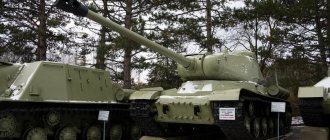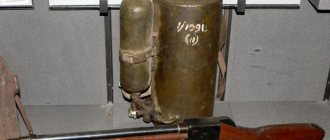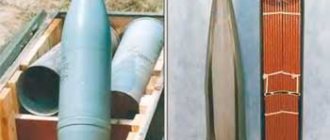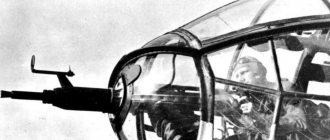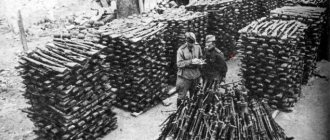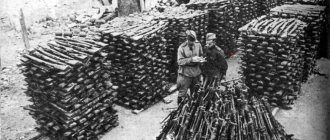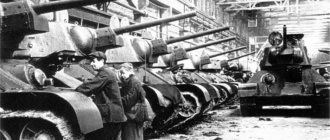23-mm aircraft gun VYa.
23-mm aircraft gun VYa (TKB-201).
Developer: A.A. Volkov, S.A. Yartsev Country: USSR Start of development: 1940 Tests: 1941
At TsKB-14, designers A.A. Volkov and S.A. Yartsev created the 23-mm automatic cannon TKB-201, later called VYa, for the new 23-mm cartridge. The TKB-201 drawings were ready by May 6, 1940. The operation of the automation is based on the principle of using the energy of powder gases removed from the barrel bore. The shutter is sliding. Wedge locking. The machine was powered by a link metal tape.
The cartridge feed is “two-story”, the refueling is direct. After each burst, the moving parts of the gun stopped on the sear in the extreme position, which eliminated the possibility of ignition of the charge in the chamber from the barrel, which heated up during firing.
When loading and reloading the gun (after a delay), the moving parts were retracted to the rearmost position using a pneumatic loading mechanism.
The advantage of the VYa assault rifle was its high rate of fire with high shot power for such a caliber, the disadvantage was the high recoil and sharp operation of the mechanisms.
Large recoil necessitated the need to install an automatic shock absorber, usually with a spring shock absorber. The abrupt operation of the mechanisms reduced the survivability of parts and caused delays, many of which could not be eliminated in the air.
The length of the VYa cannon barrel is 1657 mm. Gun dimensions: length - 2145 mm, width - 162 mm; height - 212 mm. The weight of the gun is 66 kg. Rate of fire - 550-650 rounds/min.
The ammunition of the VYA gun included fragmentation-incendiary, fragmentation-incendiary-tracer and armor-piercing incendiary shells. The weight of all shells was the same - about 200 g, i.e. twice as much as the 20 mm ShVAK cannon. The fragmentation shell contained 10 g of explosive. The explosive effect of the fragmentation projectile of the VYa cannon was twice as great as that of the 20-mm ShVAK cannon.
In the first half of 1941, development of the 23-mm cartridge with an armor-piercing incendiary projectile was completed. The projectile consisted of a body of a sub-caliber armor-piercing core, a duralumin ballistic tip and a checker with 6 g of incendiary substance placed inside the body. A shell at a distance of 400 m normally penetrated 25 mm armor.
In the absence of a production Il-2 aircraft for which the cannon was made, the first flight tests of the TKB-201 cannon were carried out on a Messerschmitt-110 (1940). The gun was installed in the fuselage; installation for it was done at the Mikoyan Design Bureau under the leadership of N.I. Volkov.
At first, despite the relatively good data of the TKB-201, preference was given to the MP-6 cannon, which was put into production. However, the shortcomings of the MP-6 forced the command to conduct repeated comparative tests of the TKB-201 and MP-6 in April-May 1941. This time TKB-201 was installed on the Il-2. Based on the test results, the TKB-201 gun was put into service in May 1941 under the designation VYa. Installed on aircraft: Il-2, Il-10.
The recoil of the VYa cannon was so great that they did not dare install it on fighters. Its only carrier was the Il-2 attack aircraft, each wing of which was equipped with one VYa cannon with 150 rounds of ammunition per barrel.
VYa guns were produced at two factories (No. 2 and No. 66). In 1942, 13,420 units were produced, in 1943 - 16,430, in 1944 - 22,820, in 1945 - 873, in 1946 - 2,002 and in 1947 - 1,247 units. Total 64655 guns.
TTX:
Barrel length, mm: 1657 Caliber, mm: 23 x 152 Gun dimensions, mm - length: 2145 - width: 162 - height: 212 Gun weight, kg: 66 Rate of fire, rounds/min: 550—650 Initial speed, m/s: 900
Aircraft gun VYA-23.
Aircraft gun VYA-23.
VYA-23 cannon in the wing of an Il-2 attack aircraft.
Gunsmiths service the VYa-23 air cannon.
Assembly of VYa-23 aircraft guns at the Tula Machine-Building Plant.
.
.
Source: A.B. Shirokorad. History of aviation weapons.
Guns for "flying tanks"
September 2 marked the 115th anniversary of the birth of the famous Tula gunsmith Sergei Aleksandrovich Yartsev, one of the creators of the VYa (Volkov-Yartsev) aircraft cannon, which was equipped with Soviet attack aircraft during the Great Patriotic War. On this day, the Tula regional branch of the Union of Mechanical Engineers of Russia organized an excursion to the Weapons Museum for employees of defense industry enterprises.
The pursuit of knowledge
The Tula Regional Office of the Russian Mechanical Engineers Union regularly initiates events aimed at popularizing the weapons history of our region and preserving the memory of the life and work of legendary designers. In this he is helped by fruitful cooperation with the Tula State Museum of Weapons, the collection of which is rightfully considered one of the best not only in Russia, but also in the world. This time, employees of JSC Tulatochmash, FBU TsSM, JSC Instrument Design Bureau named after. Academician A.G. Shipunov" and its branch - TsKIB SOO.
Sergei Aleksandrovich Yartsev (1906–1981) is a hereditary gunsmith, he was born in Tula into the family of a worker at the Imperial Tula Arms Factory. The Yartsevs lived a difficult, poor life, but the parents still sent their son to school: he really wanted to study. Sergei was nine years old when, while playing in the yard, he fell unsuccessfully, seriously injured his leg in the joint, underwent surgery, and then fell ill with bone tuberculosis. The boy lay in bed for two years until he recovered, and went back to school on crutches. And a year later, Sergei’s mother died of typhus...
It was during this difficult time for the family that the character of the future designer began to take shape. He decided to continue his studies. After graduating from high school, he entered a vocational school at an arms factory - here he mastered the professions of a turner and a draftsman-copier. And then he got a job as a turner in a workshop where they made barrels for the Maxim-Tokarev light machine gun. At this time, the TOZ group, which included the legendary designers P. P. Tretyakov and I. A. Pastukhov, was converting the Maxim machine gun into an aviation one, and Yartsev took an active part in this work. The young man's talent was noticed, and he was transferred to a design bureau, where he worked as a copyist and then as a draftsman. Over time, Yartsev began to be trusted with the development of individual parts. He really liked the new business, but there was clearly not enough special technical education, and Sergei Alexandrovich entered the Tula Evening Mechanical College.
Under the wing of a stormtrooper
In 1940, several of the country's leading design organizations were tasked with developing a 23 mm aircraft cannon, with a muzzle velocity of about 900 meters per second and a rate of fire of 600 rounds per minute. In the Tula Design Bureau, this was entrusted to the designers A. A. Volkov and S. A. Yartsev, who had previously worked on the creation of an aircraft gun, only of 20 mm caliber.
The task turned out to be difficult: the first sample of the TKB-201 gun was ready by May 1940, but technical problems were discovered during testing. Tula designers had to work hard and persistently to eliminate the shortcomings, and TKB-201, later called “VYA-23” (Volkova-Yartseva), was put into service. During the Great Patriotic War, it was precisely these guns that were equipped with the Soviet IL-2 attack aircraft, which our soldiers called “flying tanks”, and the Germans called them “the Black Death”.
The VYA-23 had many advantages, first of all, a high rate of fire: up to 650 rounds per minute with high shot power for such a caliber. There were also disadvantages - in particular, high recoil and abrupt operation of the mechanisms, which affected the “survivability” of the parts. It was because of this factor that VYA-23 was not installed on fighters. But for the IL-2, the Volkov-Yartsev cannon turned out to be the optimal weapon: the plane had two cannons, one on the wing, with a reserve of 150 rounds of ammunition for each.
For the development of VYa-23, Volkov and Yartsev were awarded the Stalin Prize in 1941.
In the post-war years, S.A. Yartsev was improving the famous cannon - its new modification could fire 700 rounds per minute. In the 50s, Sergei Aleksandrovich headed the design team that developed a 37-mm aircraft gun with a rate of fire of up to 800–890 rounds per minute.
In 1960, Sergei Alexandrovich and a large group of designers were transferred to TsKIB SOO. He headed the design department and took part in a number of research projects. He developed experimental samples of the 7.62-mm TKB-041 heavy-fire machine gun with a rate of fire of 7,000 rounds per minute; a small machine gun chambered for a special cartridge TKB-061; 23-mm automatic cannon TKB-0105; 5.6 mm machine guns chambered for a special cartridge TKB-590, TKB-0106.
S. A. Yartsev retired from TsKIB SOO in June 1980, being a pensioner of union significance. Died July 9, 1981.
Traditions of Tula gunsmiths
...A tour of the Weapons Museum for Soyuzmash guests was conducted by the deputy head of the excursion department, Ilya Kladov. He spoke in particular detail about the legendary VYa-23 - a sample of the Volkov-Yartsev cannon is presented in the permanent exhibition.
“Studying the history of weapons production is necessary; it is important to know how it developed, especially since the technical solutions of the past are still in use today,” says Ivan Vlasov, a specialist at the branch of KBP JSC – TsKIB SOO. – Of course, I’ve heard about designer Yartsev before. During my years of study - I graduated from Tula State University three years ago - we were told that he developed an aircraft cannon that was effective during the war. And today I saw this gun - the impression was strong, in fact it was a very complex design...
“I’m glad to have the opportunity to once again visit our wonderful Museum of Weapons, you can come here endlessly - you always learn something new,” says Alexander Sharapov, a specialist at the branch of KBP JSC - TsKIB SOO. – I’m even more glad to do this today, when the 115th anniversary of the birth of Sergei Aleksandrovich Yartsev is celebrated. His most significant development, the VYa-23, was significant not only for its time; much of what the designers of those years invented is still relevant today.
“Sergey Aleksandrovich Yartsev is a unique person, he is one of those who forged Victory in the Great Patriotic War,” said Alexander Blagoveshchensky, executive director of the Tula Regional Union of Mechanical Engineers of Russia. – Today’s anniversary is one of the most important dates in the weapons history of Tula and Tula, which makes it possible to draw attention to the name of the famous designer and learn more about his life and work. We organize excursions of this kind not only for enterprise employees, but also for schoolchildren. Young people must know history in order to continue the glorious traditions of Tula gunsmiths. We are grateful to the Tula State Weapons Museum for cooperation and assistance in implementation.
- A gun
- Museum
- Soyuzmash
- Yartsev
Tell everyone about it!
Subscribe to our channel on Yandex.News
Battle for the sky
The work of workers at defense enterprises during the Great Patriotic War is difficult to overestimate. The factories that are part of the Rostec State Corporation today produced a wide range of front-line products: from raw materials to small arms and aircraft bombs.
Of course, the greatest victory in the history of the country could not be achieved without establishing air supremacy. The firepower of the Russian Army Air Force was strengthened by high-speed aircraft machine guns and cannons from famous Soviet weapons designers Shpitalny, Vladimirov, Volkov, Yartsev. Our aviation was armed with: ShKAS (1800 rpm), ShVAK (700-800 rpm), Berezina (800-1050 rpm) machine guns. Their development and production were carried out by the Tula Arms and Izhevsk Machine-Building Plants.
It is worth noting that the development of all types of weapons at the factories that are part of Rostec today occurred at a record pace during the war.
ShKAS aircraft machine gun
There is a curious incident associated with this machine gun. During the celebration of the 20th anniversary of the Victory, one of the Tula newspapers told readers that in the victorious year of 1945, Soviet soldiers discovered a Tula 7.62-mm ShKAS air machine gun in Hitler's Reich Chancellery. The gun stood under a glass cover, and an order hung next to it. It said that the ShKAS would be displayed in the chancellery until German specialists created the same one for the Luftwaffe.
Boris Shpitalny was born in 1902. After graduating from the Moscow Mechanical Institute in 1927, after working a little at the Moscow Scientific Automotive Institute, he moved to the design bureau of the Tula Arms Plant. There he came up with a proposal for a project for a rapid-firing aircraft machine gun. The first sample of ShKAS was ready by mid-autumn 1930.
Despite its light weight (about 10 kilograms) and compactness, the machine gun had an exceptionally high rate of fire - 1800 rounds per minute, which was not found in any foreign type of automatic weapon. In the future, for several more years, factory designers worked on improving the ShKAS.
On October 1, 1932, the 7.62-mm aviation machine gun of the Shpitalny-Komaritsky system (ShKAS) was put into service. The creators of the machine gun noted the exceptionally high rate of fire of their brainchild. It was achieved due to the short stroke of the moving parts and the combination of a number of reloading operations. The effectiveness of fire was increased by specially created cartridges with tracer, incendiary and armor-piercing incendiary bullets. The turret and wing versions of the machine gun were created in the winter of 1934. In 1933, 365 aircraft machine guns were manufactured, and in 1940 their production increased to 34,233 units.
ShKAS and its subsequent modifications were installed on aircraft until the end of the Great Patriotic War. The quality of the ShKAS was appreciated in particular by the pilots of Republican Spain, where they found their first combat use.
ShVAK air cannon
On February 9, 1931, the designers were given the task of developing and manufacturing a 12.7 mm aircraft machine gun for firing both through a propeller and from a turret using the Shpitalny system. A sample of such a machine gun was developed by Vladimirov at the beginning of 1932 and was already manufactured on May 28. In 1935, serial production of ShVAK began. The machine gun turned out to be a powerful weapon for fighting enemy fighters, but the high-explosive effect of its explosive bullets was insufficient. We decided to develop a larger caliber system.
The design of the 20-mm ShVAK cannon was identical to the 12.7-mm machine gun of the same name. The only difference was in the diameter of the bore. The gun is powered by a belt, reloading is pneumatic or mechanical.
In 1936, the first model of the 20-mm ShVAK (Shpitalny, Vladimirov aviation large-caliber) cannon appeared in service with the Soviet army, which was widely used during the Great Patriotic War. A new element in its design was a push-pull feed - the cartridge belt moved both during rollback and during rolling of the moving parts. For this gun, they developed cartridges with fragmentation tracer shells and combined-action shells: armor-piercing incendiary and fragmentation incendiary. In terms of tactical and technical characteristics, the ShVAK, like the ShKAS, was far superior to the best foreign models of cannon airborne weapons of that time.
It is curious that the 20-mm ShVAK cannon, produced at the Kovrov plant, found application not only in aviation, but in tank building. In 1941, the guns were installed on light T-60 tanks, which increased the power of their fire tens of times, and increased the target range to 7 kilometers. T-60s took part in battles against Istroy in December 1941 during the historical Battle of Moscow.
During the war, 37 thousand Yakovlev fighters, 22 thousand Lavochkin aircraft, 40 thousand Il-2 attack aircraft (ShVAK and VYa guns) were armed with ShVAK cannons. Each attack aircraft was equipped with two cannons.
Berezina air machine gun
The rapid development of aviation in the 40s required increasingly powerful weapons. In April 1941, the UB-12.7 machine gun was adopted and mass-produced in Tula. Created on the basis of the BS large-caliber synchronous machine gun developed by Tula designer Mikhail Berezin, the UB-12.7 machine gun became one of the main types of aviation weapons at the very beginning of the war. It outperformed ShKAS in terms of characteristics. Although at the front, of course, any extra barrel was important and needed.
The automatic operation of the machine gun is based on the use of the energy of powder gases, some of which were vented through a special tube from the barrel and affected the reloading mechanisms. The bolt was cocked while simultaneously feeding a cartridge from the tape using a special pneumatic device. The machine gun was very reliable. It was possible to fire from it even at very low temperatures.
In the synchronized version (UBS), the machine gun was installed on the LaGG-3 Yak-1, Yak-7, Yak-3 fighters. in the wing and turret - on the Pe-2 pe-2, Il-2, U-2, Tu-2, Pe-8 and on the American A-20 bombers received under Lend-Lease.
Automatic cannon VYa
In 1940, designers Volkov and Yartsev created the VYa automatic cannon with a caliber of 23 mm. Combined-action projectiles were developed for it: armor-piercing incendiary and fragmentation incendiary. The initial speed of the projectile is 900 m/s (100 m/s more than the ShVAK projectile), weight is 200 g (for the ShVAK it is 96 g). From a distance of 400 m, it pierced an armor plate 25 mm thick, and hitting a gas tank almost always led to its explosion. First of all, Il-2 attack aircraft, and then some fighters, were armed with VYa cannons - in combination with machine guns. The foreign air forces on both sides of the Second World War did not have such a gun in service.
During the war years, 48,186 23mm caliber guns were manufactured. Towards the end of the war, they were installed as part of a twin installation 2-U-23 for armed boats, and as part of a quad installation 4-U-23 - for arming submarines of the country's Navy.
NS-37 gun
The 37-mm NS-37 cannon was accepted for mass production in 1942. It was developed by a team headed by Nudelman and Suranov. Together with the ShVAKs, the NS-37 was made at the Izhevsk Machine-Building Plant.
By this time, about 25 thousand aircraft machine guns had been manufactured. At the same time, the Tula and Izhevsk factories manage to work for other enterprises - producing barrels for various types of small arms, equipment and tools. In 1943, Izhmash produced about 3 million rifles of various types, more than 40 thousand Berezin air machine guns and about 4,800 Nudelman-Suranov air guns. In October 1944, production of the 20-mm Berezin B-20 air cannon began in Izhevsk - within two months its production increased by 285%.
By 1945, weapons production at Izhmash had almost tripled compared to 1941. In 1945, the Izhevsk Machine-Building Plant produced 20 types of military equipment. In total, during the war years, more than 11 million rifles and carbines, more than 15 thousand aircraft guns, and more than 130 thousand anti-tank guns were produced here. In addition, the urgent need to constantly increase production rates has become the reason for the introduction of new technologies. So, for example, if in peacetime the barrel processing cycle lasted 22 hours, then during war it was reduced to 2 hours.
In comparison with other similar guns, the NS-37 had better indicators in terms of reliability, dimensions, weight, rate of fire, and was more technologically advanced. It had a short barrel stroke, spring-hydraulic knurling, and belt-fed cartridges. The feed mechanism was powered by a special spring, cocked when the barrel was rolled back. Its ammunition consisted of armor-piercing incendiary tracer and fragmentation incendiary tracer shells. The gun was installed on LaGG-3 and Yak-9T fighters in the collapse of the engine blocks for firing through the propeller hub, and on attack aircraft - under the wings
The gun has proven itself to be a reliable and formidable weapon. According to the pilots, a single shell hit was enough for the enemy plane to “fall in separate pieces to the ground.” The gun was simple to operate, got dirty a little, had no delays in firing, and showed excellent performance in battles.
